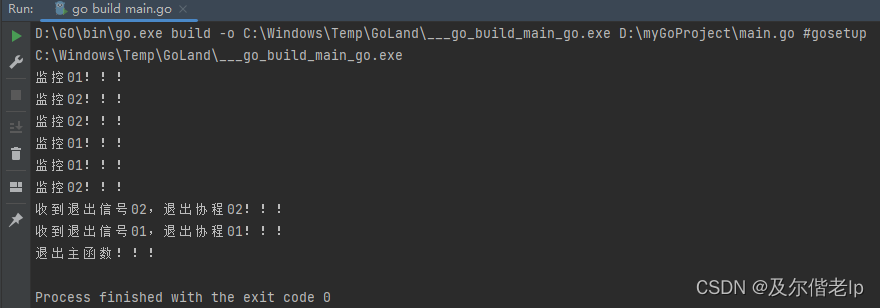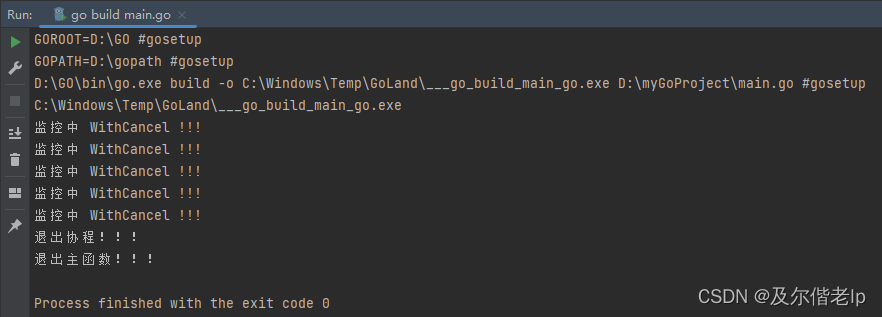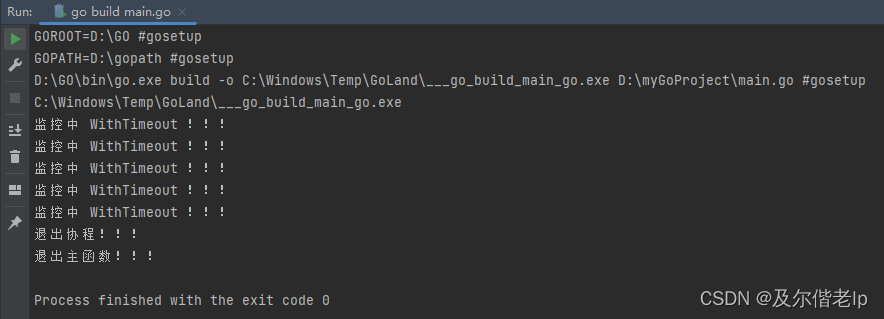default:
fmt.Println("监控中!!!")
time.Sleep(1 \* time.Second)
}
}
}()
time.Sleep(3 \* time.Second)
// 向退出通道发送退出信号
ch <- true
fmt.Println("退出主函数!!!")
}

#### 2、关闭退出通道
退出多个 goroutine。
当 goroutine 过多时,我们就需要向退出通道中发送多次退出信号,如果再用发送信号的方式就很麻烦,有一个很简单的方法,关闭 channel,这样所有监听退出 channel 的 goroutine 就都会收到关闭信号。
func main() {
// 定义退出通道
ch := make(chan bool)
go func() {
for {
select {
case <-ch:
fmt.Println(“收到退出信号01,退出协程01!!!”)
return
default:
fmt.Println(“监控01!!!”)
time.Sleep(1 * time.Second)
}
}
}()
go func() {
for {
select {
case <-ch:
fmt.Println(“收到退出信号02,退出协程02!!!”)
return
default:
fmt.Println(“监控02!!!”)
time.Sleep(1 * time.Second)
}
}
}()
time.Sleep(3 * time.Second)
// 关闭退出通道
close(ch)
time.Sleep(5 * time.Second)
fmt.Println(“退出主函数!!!”)
}

#### 3、使用context.WithCancel() 方法
使用 context.WithCancel() 方法,手动调用 cancel() 方法退出 goroutine。
只有创建它的函数才能调用取消函数来取消此 context。如果你愿意,可以传递取消函数,但是,强烈建议不要这样做,这可能导致取消函数的调用者没有意识到取消 context 的下游影响,可能存在源自此的其他 context,可能导致程序以意外的方式运行。简而言之,永远不要传递取消函数。
func main() {
// 新建一个上下文
ctx := context.Background()
// 在初始上下文的基础上创建一个有取消功能的上下文,需要取消时,就调用cancel(),发出取消信号
ctx, cancel := context.WithCancel(ctx)
go func() {
for {
select {
case <-ctx.Done():
fmt.Println(“退出协程!!!”)
return
default:
fmt.Println(“监控中 WithCancel !!!”)
time.Sleep(1 * time.Second)
}
}
}()
time.Sleep(5 \* time.Second)
// 取消信号
cancel()
time.Sleep(2 \* time.Second)
fmt.Println("退出主函数!!!")
}

#### 4、使用context.WithTimeout() 方法
使用context.WithTimeout() 方法,手动调用 cancel()方法,在超时之前退出 goroutine。
func main() {
ctx, cancel := context.WithTimeout(context.Background(), time.Second*10)
go func() {
for {
select {
case <-ctx.Done():
fmt.Println(“退出协程!!!”)
return
default:
fmt.Println(“监控中 WithTimeout !!!”)
time.Sleep(1 * time.Second)
}
}
}()
time.Sleep(5 * time.Second)
cancel()
time.Sleep(2 * time.Second)
fmt.Println(“退出主函数!!!”)
}

#### 5、使用context.WithDeadLine()方法
使用 context.WithDeadLine() 方法,在指定的时间退出 goroutine。
func main() {
nowTime := time.Now().Add(3 * time.Second)
ctx, _ := context.WithDeadline(context.Background(), nowTime)
go func() {
for {
select {
case <-ctx.Done():
fmt.Println(“退出协程!!!”)
return
default:
fmt.Println(“监控中 WithDeadline !!!”)
time.Sleep(1 * time.Second)
}
}
}()
time.Sleep(5 * time.Second)
fmt.Println(“退出主函数!!!”)
}

### 四、可以在 goroutine A 里去停止 goroutine B 吗?
不可以,因为在 Go 语言中,goroutine 只能自己主动退出,一般通过 channel 来控制,不能被外界的其他 goroutine 关闭或干掉,也没有 goroutine 句柄的显式概念。goroutine 不可以跨 goroutine 强制停止。记住,在 Go 语言中每一个 goroutine 都需要自己承担自己的任何责任,这是基本原则。
>
> 在 Go issues 中也有人提过类似问题,Dave Cheney 给出了一些思考:
>
>
> * 如果一个 goroutine 被强行停止了,它所拥有的资源会发生什么?堆栈被解开了吗?defer 是否被执行?
> 如果执行 defer,该 goroutine 可能可以继续无限期地生存下去。
> 如果不执行 defer,该 goroutine 原本的应用程序系统设计逻辑将会被破坏,这肯定不合理。
> * 如果允许强制停止 goroutine,是要释放所有东西,还是直接把它从调度器中踢出去,你想通过此解决什么问题?
>






















 被折叠的 条评论
为什么被折叠?
被折叠的 条评论
为什么被折叠?








